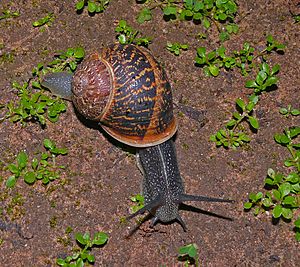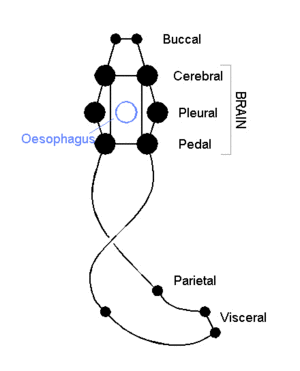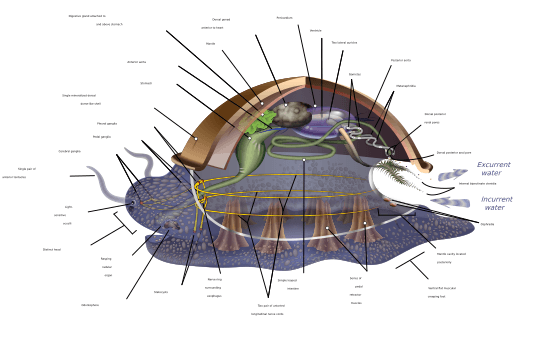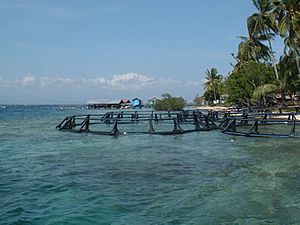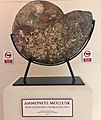Mollusc facts for kids
Quick facts for kids Molluscs |
|
|---|---|
 |
|
| Caribbean reef squid, Sepioteuthis sepioidea | |
| Scientific classification | |
| Kingdom: | |
| Phylum: |
Mollusca
Linnaeus, 1758
|
Molluscs are a big group of invertebrate animals. This means they don't have a backbone. Most molluscs live in the sea, especially in shallow waters near the shore. They are the largest group of marine animals, with about 85,000 different living species. That's about 23% of all known marine creatures! You can also find molluscs in freshwater and on land.
Molluscs are incredibly varied. They come in many shapes, sizes, and behaviors. This is why there isn't one simple English word for the whole group. Scientists say molluscs are like "plastic material" because they can change and adapt so much. They have much more variety than their ancient rivals, the brachiopods.
Most molluscs have shells. But some groups, like octopuses, slugs, and sea slugs, do not have shells.
Contents
Amazing Diversity of Molluscs
Many molluscs live in freshwater and on land. They are very diverse, not just in how big they are or how their bodies are built. They also show great variety in their behavior and the places they live.
Scientists usually divide molluscs into 9 or 10 main classes. Two of these classes are completely extinct, meaning they no longer exist. Cephalopod molluscs, like squid, cuttlefish, and octopus, are some of the smartest invertebrates. They have good brains and show complex behaviors. The giant squid or the colossal squid is the largest known invertebrate animal.
The gastropods (which include snails and slugs) are the most common molluscs. They make up 80% of all known mollusc species. The scientific study of molluscs is called malacology.
Key Features of Molluscs
There are three main things that define modern molluscs:
- They have a mantle with a special space called a cavity. This cavity is used for breathing and getting rid of waste.
- They have a radula, which is like a rough tongue used for feeding.
- They have a specific type of nervous system.
Because molluscs are so varied, many science books use a "hypothetical ancestral mollusc" to explain their basic features. Imagine a mollusc with a single, limpet-like shell on top. This shell is made of proteins and a tough material called chitin, strengthened with calcium carbonate. The mantle, which covers the top surface, creates this shell. The bottom of the animal has a single, strong, muscular "foot."
Molluscs eat using their rasping "tongue," the radula. Their complex digestive system uses mucus and tiny, muscle-powered "hairs" called cilia. Most molluscs have two pairs of nerve cords, but bivalves have three. If a mollusc has a brain, it usually wraps around the esophagus. Most molluscs have eyes, and all have sensors to detect chemicals, vibrations, and touch.
How Molluscs Use Their Organs
A cool thing about molluscs is that they often use the same body part for many jobs. For example, their heart and "kidneys" (called nephridia) are important for reproduction, blood circulation, and getting rid of waste. In bivalves, their gills help them breathe. They also create a water current in the mantle cavity, which helps with waste removal and reproduction. Some molluscs can even change their gender to help with breeding.
Scientists have found good evidence that gastropods, cephalopods, and bivalves appeared during the Cambrian period. This was about 541 to 485.4 million years ago. How molluscs first evolved from their ancestors before that time is still a bit of a mystery.
Some mollusc species can be harmful or become pests for humans. The bite of the blue-ringed octopus can be very dangerous. Stings from some large tropical cone shells can also be deadly. Their venoms are now used by scientists to study the nervous system. A disease called Schistosomiasis is spread to humans by water snails. It affects about 200 million people. Snails and slugs can also cause serious damage to farms. Sometimes, when snail species are accidentally or purposely brought to new places, they can harm the local ecosystems.
What is a "Generalized Mollusc"?
Because molluscs have so many different body types, many textbooks start by describing what's called an archi-mollusc. This is also known as a hypothetical generalized mollusc or HAM. It helps to show the most common features found in the mollusc group. This idea is similar to modern monoplacophorans. Some scientists think it might look like very early molluscs.
The generalized mollusc is symmetrical, meaning both sides are mirror images. It has a single, limpet-like shell on top. The mantle, which covers the upper surface, creates this shell. The bottom part of the animal has a single, muscular "foot." The "visceral mass" is the soft, non-muscular part of the mollusc's body. It contains all the important internal organs.
Mollusc Families (Taxonomy)
Here are some of the main groups (classes) of molluscs:
- Aplacophora: These living molluscs do not have shells.
- Bivalvia: This group includes most shellfish like clams, oysters, scallops, and mussels.
- Cephalopoda: This group includes Squid and Octopus.
- Gastropoda: This group includes whelks, limpets, snails, slugs, and Nudibranchs.
- Monoplacophora: These molluscs have a shell that looks like a cap.
- Polyplacophora: These are the Chitons.
- †Rostroconchia: This is a group of molluscs that are now extinct.
- Scaphopoda: These are known as the tusk shells.
How Humans Interact with Molluscs
For thousands of years, molluscs have been a source of food for people. They have also provided important luxury items. These include pearls, mother of pearl, Tyrian purple dye, and sea silk. Their shells were even used as a type of currency in some older societies. However, some mollusc species can bite or sting humans. Also, some have become pests in farming.
Uses by Humans
Molluscs, especially bivalves like clams and mussels, have been an important food source for a very long time. Sometimes, too many are caught, which is called overfishing. Other molluscs that people commonly eat include octopuses, squids, whelks, oysters, and scallops. In 2005, China caught 80% of all molluscs globally, which was almost 11 million tons. Some countries have rules about importing and handling molluscs. This is mainly to reduce the risk of toxins that can sometimes build up in these animals.
Most molluscs with shells can make pearls. But only the pearls from bivalves and some gastropods are valuable. These valuable pearls come from shells lined with a shiny material called nacre. The best natural pearls come from marine pearl oysters, Pinctada margaritifera and Pinctada mertensi. These oysters live in the warm waters of the Pacific Ocean. Natural pearls form when a tiny foreign object gets stuck between the mantle and the shell.
There are two ways to grow pearls on farms. One way uses "seeds" (small pieces of ground shell) put into oysters. The other way uses beads. Collecting too many freshwater mussels for these "seeds" has put some mussel species in the southeastern United States in danger. The pearl industry is so important in some areas that a lot of money is spent on keeping farmed molluscs healthy.
Other fancy and high-status items were made from molluscs. Tyrian purple dye, made from the ink glands of murex shells, was extremely valuable. In ancient times, it was said to be worth its weight in silver. The discovery of many Murex shells on Crete suggests that the Minoans might have been the first to get this "imperial purple" dye. This was centuries before the Tyrians. Sea silk is a very fine, rare, and valuable fabric. It is made from long, silky threads (called byssus) that several bivalve molluscs produce. They use these threads to attach themselves to the sea bed. An ancient writer named Procopius mentioned that rulers in Armenia wore cloaks made from lana pinna (sea silk). It seems only the ruling classes were allowed to wear these special cloaks.
Mollusc shells, including cowries, were used as a type of money in some societies before modern industry. However, these "currencies" were different from the money we use today. Some shell "currencies" were not used for everyday shopping. They were mainly used to show social status at important events like weddings. When they were used for buying and selling, their value changed from place to place. This was often because it was hard to transport them. Their value could also drop if it became easier to get more shells.
Harmful to Humans
Stings and Bites
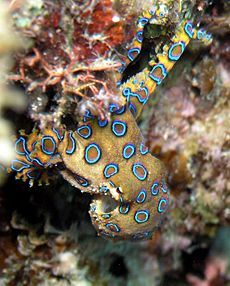
Some molluscs can sting or bite. However, deaths from mollusc venoms are much less common than deaths from jellyfish stings.
All octopuses are venomous, but only a few types are truly dangerous to humans. Blue-ringed octopuses, found around Australia and New Guinea, only bite if they are greatly bothered. But their venom can be very dangerous. Another tropical species, Octopus apollyon, can cause bad inflammation that lasts over a month, even with treatment. The bite of Octopus rubescens can cause tissue damage that lasts longer than a month if not treated. It can also cause headaches and weakness for up to a week, even with treatment.
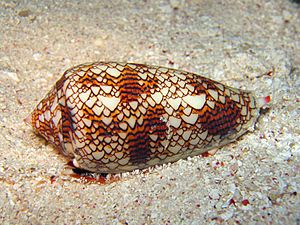
All species of cone snails are venomous. They can sting painfully if handled. Many species are too small to be a big risk to humans. Only a few deaths have been officially reported from cone snail stings. Their venom is a complex mix of toxins. Some act fast, while others are slower but more dangerous. The way individual cone-shell toxins affect the nervous system is so precise. This makes them useful tools for research in neurology. Also, their small size makes it easy for scientists to create them in the lab.
Images for kids
-
The use of love darts by the land snail Monachoides vicinus is a form of sexual selection
-
The enigmatic Kimberella quadrata (fossil pictured) from the Ediacaran has been described as being "mollusc-like" because of its features which are shared with modern day molluscs.
-
Skin vesicles created by the penetration of Schistosoma. (Source: CDC)
See also
 In Spanish: Mollusca para niños
In Spanish: Mollusca para niños



